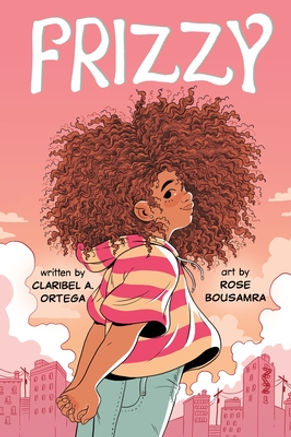
📘 Frizzy
Words by Claribel A. Ortega Illustrations by Rose Bousamra
Genre/Category: This book fulfills the requirement of having a Pura Belpre Award book.
Target Age Group: Ages 9-18
Format Read: Physical Copy
🌀 Plot Summary (1–2 Sentences)
This graphic novel follows Marlene, a young girl who loves art, her cool Tía Ruby, and her best friend, just not the salon. Every Sunday, she’s expected to get her hair “fixed,” but as the story unfolds, Marlene begins a personal journey of self-love, family healing, and embracing her natural hair, ultimately challenging the pressure to conform to beauty standards rooted in generational expectations.
✅ Why I Chose This Book
At first, I was going to read Mexikid because I saw it on the Pura Belpré Award list and thought it would be a good read. However, as luck would have it, Frizzy was being checked in, and I noticed the award sticker on the cover. I’m currently on my own hair journey, so I immediately felt this book was calling to me. As a daughter of older traditional parents, I was also expected to have my hair tidy or not in my face. When I was younger that would be easy since my mom was the one who usually did my hair, but as I started growing up, my hair became more like my dad's. Thick, darker, curly, and way frizzier. Every time I go to the hair salon there has not been one time where I don't hear a resemblance of 'tienes mucho cabello' or 'tu pelo estan bien grueso' meaning 'you have so much hair' or 'your hair is so thick'. I also have a mother that would always comment on me to 'straighten' my hair, so it looks pretty. I am still trying to find out what's best for my hair and after reading this book I felt like I gained more confidence about my hair. Which if it helped me, a 24-year-old, I'm sure it'll be a positive influence for other children and young adults!
🔍 Elements
1. Illustrations
The illustrations accurately capture what it’s like to deal with frizzy hair. I appreciated how the artist broke up the hair process into detailed panels, showing the different steps involved, whether it’s at the salon, with her mom, or by herself. It visually communicated how time-consuming and painful the process can be. The tiny out-of-place strands Marlene has when her hair is frizzy were a subtle but powerful detail that added authenticity to the experience.
2. Theme
I love the message this novel spreads. While some may think it’s just about hair, it dives much deeper into cultural identity, generational pressure, and the importance of self-acceptance. In many cultures, hair carries meaning, whether it’s expected to be long, short, straight, or "tidy", and those expectations can weigh heavily on young people. The story gently opens up a conversation about breaking cycles and embracing one’s natural self. It also shows how hard it can be to talk about change with family, especially when it challenges long-held beliefs. Frizzy encourages readers to honor tradition while also recognizing when it’s time to make space for new expressions of identity and beauty.
3. Characters
I especially loved the heart-to-heart between Marlene and her mom near the end. This emotional moment shows Marlene’s bravery as she expresses her true feelings and challenges her mother’s beliefs, without disrespect, but with honesty and vulnerability. It also reveals her mom’s willingness to listen and grow. That scene stood out as a turning point where both characters begin to heal. Marlene’s growth throughout the book is inspiring; she moves from quietly enduring the weekly salon trips to confidently embracing her curls. Her mom’s character also grows as she begins to understand how old standards can unintentionally hurt the ones we love. Their relationship shows how communication can bring about understanding and change within a family.
📚 Reference
Ortega, C. A. (2022). Frizzy (R. Bousamra, Illus.). First Second.